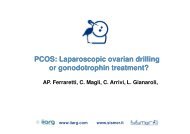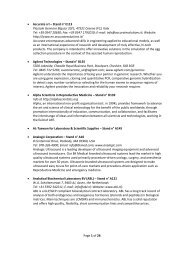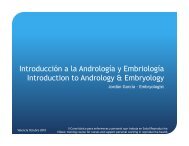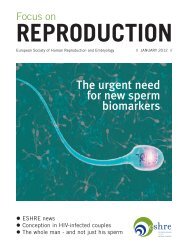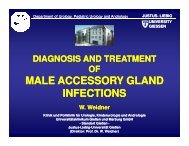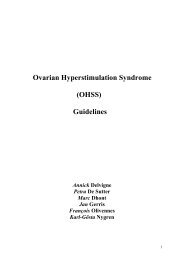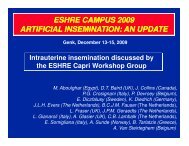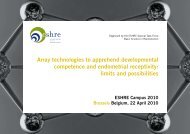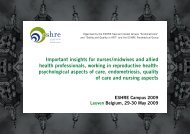Good Clinical Treatment in Assisted Reproduction - An ESHRE ...
Good Clinical Treatment in Assisted Reproduction - An ESHRE ...
Good Clinical Treatment in Assisted Reproduction - An ESHRE ...
You also want an ePaper? Increase the reach of your titles
YUMPU automatically turns print PDFs into web optimized ePapers that Google loves.
<strong>Good</strong> <strong>Cl<strong>in</strong>ical</strong> <strong>Treatment</strong> <strong>in</strong> <strong>Assisted</strong><strong>Reproduction</strong> ‐ <strong>An</strong> <strong>ESHRE</strong> position paperEXECUTIVE SUMMARY June 2008The prevalence of <strong>in</strong>fertility is <strong>in</strong>creas<strong>in</strong>g <strong>in</strong> the developed world. The postponement of pregnancy, greaterprevalence of obesity and sexually transmitted <strong>in</strong>fections all contribute to the problem. This trend has beenacknowledged by the European Parliament, which <strong>in</strong> February 2008 called on Member States "to ensure theright of couples to universal access to <strong>in</strong>fertility treatment”. As a result, there exists a progressive need formedical help <strong>in</strong> resolv<strong>in</strong>g reproductive disorders.<strong>ESHRE</strong>, as the European body for professionals <strong>in</strong> reproductive medic<strong>in</strong>e and biology, has through itsmembership always aimed to provide childless couples with the best possible management of their fertilityproblems, while at the same time ensur<strong>in</strong>g that they are not exposed to unnecessary risks or <strong>in</strong>effectivetreatments. It is <strong>ESHRE</strong>'s view that the treatment of <strong>in</strong>fertility should be based on a balanced choice from thebest available evidence, with respect both to efficacy and safety. <strong>ESHRE</strong> promotes improvements <strong>in</strong> medical andlaboratory practice and encourages, through its educational activities and tra<strong>in</strong><strong>in</strong>g, high quality medical care andlaboratory procedures. It is the objective of <strong>ESHRE</strong> to describe <strong>in</strong> this position paper the pr<strong>in</strong>ciples of goodcl<strong>in</strong>ical treatment <strong>in</strong> assisted reproduction from an evidence‐based professional perspective.Accessibility is a key feature of good cl<strong>in</strong>ical care. <strong>Treatment</strong>s of proven benefit should be made easily availablethroughout Europe, irrespective of the patient's <strong>in</strong>come or place of residence. Reimbursement policies have animpact on the use of reproductive health care; a lack of reimbursement constitutes a barrier for those seek<strong>in</strong>gtreatment. Individual EU countries should provide access to publicly funded health care, <strong>in</strong>clusive of, but notlimited to, assisted reproductive technologies such as <strong>in</strong>trauter<strong>in</strong>e <strong>in</strong>sem<strong>in</strong>ation (IUI), <strong>in</strong> vitro fertilisation (IVF),and <strong>in</strong>tracytoplasmic sperm <strong>in</strong>jection (ICSI).It has been shown that 84% of couples not us<strong>in</strong>g contraception and hav<strong>in</strong>g regular sexual <strong>in</strong>tercourse willconceive with<strong>in</strong> one year; another 8% will conceive <strong>in</strong> their second year of try<strong>in</strong>g. So, the first objective of adedicated fertility <strong>in</strong>vestigation should be to identify those couples who most likely will not need medicalassistance. As <strong>in</strong>voluntary childlessness can be a psychological burden, proper counsell<strong>in</strong>g should be offeredabout all related medical, psychological and social questions. Provid<strong>in</strong>g them with easily understood evidencebased<strong>in</strong>formation should offer couples the opportunity to make <strong>in</strong>formed decisions with regard to theirreproductive future and the care they wish to receive.In couples <strong>in</strong> whom screen<strong>in</strong>g reveals a problem, further delay is not justified and treatment should be offered.This may <strong>in</strong>clude advice on lifestyle changes, eat<strong>in</strong>g habits, smok<strong>in</strong>g and stressful employment. It may also<strong>in</strong>clude medical treatment with drugs, the <strong>in</strong>duction of ovulation, surgery, <strong>in</strong>sem<strong>in</strong>ation, IVF, ICSI, and oocyte orsperm donation (sometimes after cryopreservation).Modern techniques of assisted reproduction have been accompanied by high risks <strong>in</strong> the past: ovarianhyperstimulation syndrome, thromboembolism, (high order) multiple pregnancies, surgical complications.With<strong>in</strong> <strong>ESHRE</strong>, responsibility for high quality patient care has stimulated the development of mild approaches <strong>in</strong>IVF, the encouragement of elective s<strong>in</strong>gle embryo transfer, the development of improved freez<strong>in</strong>g programmes,and the abandonment of aggressive surgical procedures <strong>in</strong> favour of m<strong>in</strong>imally <strong>in</strong>vasive surgery.In order to ensure proper monitor<strong>in</strong>g of both quality and quantity <strong>in</strong> assisted reproduction, it is important thatannual reports accord<strong>in</strong>g to the pr<strong>in</strong>ciples outl<strong>in</strong>ed by <strong>ESHRE</strong> with respect to types, efficacy, safety and risks aremade publicly available.Dedicated, responsible care for childless couples together with universal access to <strong>in</strong>fertility treatment should bea common goal of <strong>ESHRE</strong>, patient organisations and EU politicians alike.
INTRODUCTIONDespite <strong>in</strong>ternational calls for preventative measures and ready access to appropriate treatment, <strong>in</strong>fertility is stilla major problem <strong>in</strong> the developed world (United Nations 1994). The <strong>in</strong>creased prevalence of <strong>in</strong>fertility <strong>in</strong> recentyears can at least be partly attributed to such lifestyle factors as obesity and smok<strong>in</strong>g and to the high <strong>in</strong>cidenceof sexually transmitted <strong>in</strong>fections such as Chlamydia. In addition, postponement of a first pregnancy is<strong>in</strong>creas<strong>in</strong>gly common <strong>in</strong> the developed world (Commission of the European Communities 2005, Commission ofthe European Communities 2006); this too can lead to ovarian age<strong>in</strong>g and associated <strong>in</strong>fertility.The difficulty some face <strong>in</strong> access<strong>in</strong>g appropriate advice and treatment has also been recently acknowledged bythe European Parliament which, <strong>in</strong> a resolution adopted on 21 February 2008, said that it "calls on the MemberStates, therefore, to ensure the right of couples to universal access to <strong>in</strong>fertility treatment" (EuropeanParliament 2008).Taken together, they imply and reflect a progressive <strong>in</strong>crease <strong>in</strong> the need for assisted reproductive technology(ART) treatment (<strong>ESHRE</strong> EIM data).As the European body for professionals <strong>in</strong> reproductive medic<strong>in</strong>e and biology, <strong>ESHRE</strong> aims to ensure thatpatients throughout Europe receive the best possible treatment and are not exposed to unnecessary risks. Thismeans that treatments offered should be based on the best available evidence with respect to efficacy andsafety. The role of <strong>ESHRE</strong> is also to support improvements <strong>in</strong> the field of medical practice and to promote thesafety and quality of cl<strong>in</strong>ical, surgical and laboratory procedures.<strong>ESHRE</strong> considers it a fundamental pr<strong>in</strong>ciple that professionals <strong>in</strong> reproductive medic<strong>in</strong>e and biology are allowedto utilise the full biological potential of gametes and embryos. Aga<strong>in</strong>st this background, <strong>ESHRE</strong> f<strong>in</strong>ds it importantthat there is coherence between a country’s decision to support assisted reproduction and the f<strong>in</strong>ancial andregulatory strategies affect<strong>in</strong>g the quality of the service provided.The objective of this paper is to describe the pr<strong>in</strong>ciples of good cl<strong>in</strong>ical treatment with<strong>in</strong> selected areas ofassisted reproduction from an evidence‐based professional perspective. Very important areas of fertilitytreatment <strong>in</strong>clud<strong>in</strong>g surgery, problems dur<strong>in</strong>g implantation and early pregnancy are <strong>in</strong>tentionally omitted fromthis document.ACCESSIBILITYA fundamental basis for provid<strong>in</strong>g assisted reproduction is that the different treatments are easily available.Further, current evidence shows that reimbursement policies can have significant impact on the accessibility anduse of ART treatments, and that lack of medical reimbursement will act as a barrier to the use of ART.In order to provide good fertility treatment <strong>in</strong>dividual countries should provide access to publicly funded ART <strong>in</strong>a realistic, timely and dedicated manner. All countries should be <strong>in</strong> a position to document that they provide apublic programme on a scale which is consistent with the real need for ART and without a wait<strong>in</strong>g‐time that hasa negative impact on success rates.INVESTIGATION OF FERTILITY PROBLEMSPeople who are concerned about their fertility should be <strong>in</strong>formed that some 84% of couples <strong>in</strong> the generalpopulation will conceive with<strong>in</strong> one year if they do not use contraception and have regular sexual <strong>in</strong>tercourse.Additionally, they should be <strong>in</strong>formed that female fertility decl<strong>in</strong>es with age. Women and men should also be<strong>in</strong>formed about the possible negative effects of alcohol, smok<strong>in</strong>g and body weight (overweight andunderweight) on fertility, and preconceptional care should focus on assess<strong>in</strong>g the risks of treatment andpregnancy <strong>in</strong> each <strong>in</strong>dividual case. Couples who have not conceived after one year of regular unprotected sexual<strong>in</strong>tercourse should be offered further cl<strong>in</strong>ical <strong>in</strong>vestigation, <strong>in</strong>clud<strong>in</strong>g semen analysis and assessment ofovulation.
<strong>An</strong> appropriate hormonal <strong>in</strong>vestigation should be offered when there are signs of ovulation disorders. Semenanalysis should be performed based on the recommendations of WHO and <strong>ESHRE</strong>. Further tests, <strong>in</strong>clud<strong>in</strong>gcl<strong>in</strong>ical andrological <strong>in</strong>vestigation, are advised <strong>in</strong> cases where abnormalities are detected.The results of semen analysis and ovulation assessment should be known before a test of tubal patency isperformed. Women thought to have co‐morbidities should be offered laparoscopy, so that any tubal and otherpelvic pathology can be <strong>in</strong>vestigated and treated at the same time. The ovaries can be assessed by vag<strong>in</strong>alultrasound. In some cases hysteroscopy may be <strong>in</strong>dicated.Based on the outcome of the <strong>in</strong>vestigation, each couple should receive <strong>in</strong>formation which <strong>in</strong>cludes an estimateof their chance of spontaneous pregnancy and their chance of pregnancy after different treatment options. This<strong>in</strong>formation should be provided <strong>in</strong> a form that it is accessible to people with additional needs, such as those withphysical, cognitive and sensory disabilities, and those who do not speak the native language.INFORMATION AND COUNSELLINGPatients should have the opportunity to make <strong>in</strong>formed decisions about their care and treatment based onevidence‐based <strong>in</strong>formation. These decisions should be recognised as an <strong>in</strong>tegral part of the decision‐mak<strong>in</strong>gprocess. Verbal <strong>in</strong>formation should be supplemented by written and/or audio‐visual material, <strong>in</strong>clud<strong>in</strong>g<strong>in</strong>formation about other options such as adoption. Contacts to fertility support groups should be identified.As <strong>in</strong>voluntary childlessness can be a psychological burden, counsell<strong>in</strong>g should be offered which raises all relatedmedical, psychological and social questions. Counsell<strong>in</strong>g should be an <strong>in</strong>tegral part of each centre's programmeand should be performed by physicians, nurses and/or professional counsellors.Counsell<strong>in</strong>g should be offered before, dur<strong>in</strong>g and after <strong>in</strong>vestigation and treatment, irrespective of the outcomeof these procedures, and patients should be <strong>in</strong>formed that stress <strong>in</strong> the male and/or female partner can affectrelationships and have a negative <strong>in</strong>fluence on sexuality.OVULATION INDUCTIONOvulation <strong>in</strong>duction aims to restore fertility <strong>in</strong> anovulatory women. It should be offered tak<strong>in</strong>g <strong>in</strong>to accountother factors, such as male or pelvic factors, weight or eat<strong>in</strong>g disorders, stress or over‐exercise. Thus, at leastone semen analysis from the male partner should be performed before ovulation <strong>in</strong>duction is offered, and tubalpatency checked as appropriate accord<strong>in</strong>g to cl<strong>in</strong>ical history.If there are no concerns about pelvic or tubal health, it may be appropriate to perform three cycles of ovulation<strong>in</strong>duction prior to check<strong>in</strong>g tubal patency.When an ovulation disorder is present, treatment is offered accord<strong>in</strong>g to aetiology:1. Women with a low or high BMI should first be offered counsell<strong>in</strong>g with respect to eat<strong>in</strong>g habits or stress.This is also important for those suffer<strong>in</strong>g from polycystic ovary syndrome, who may resume ovulation withweight loss.2. Clomiphene citrate rema<strong>in</strong>s the first‐l<strong>in</strong>e medical treatment and can be given for up to 12 months. Patientsshould be <strong>in</strong>formed of the small risk of multiple pregnancy. <strong>An</strong>ovulatory women with polycystic ovarysyndrome and BMI >25, who have not responded to clomiphene alone, may be offered metform<strong>in</strong> <strong>in</strong>addition.3. Gonadotroph<strong>in</strong> therapy is appropriate for women who fail to ovulate or conceive with anti‐estrogentherapy (clomiphene citrate), or have hypothalamic failure or dysfunction. For the latter group, pulsatileLHRH treatment is also appropriate and generally presents a lower risk of multiple pregnancy. Nevertheless,any centre carry<strong>in</strong>g out ovulation <strong>in</strong>duction with gonadotroph<strong>in</strong>s should have facilities for regularmonitor<strong>in</strong>g with ultrasound, and expertise <strong>in</strong> monitor<strong>in</strong>g such cycles.
4. Women with hyperprolact<strong>in</strong>aemia should be offered treatment with dopam<strong>in</strong>e agonists such asbromocript<strong>in</strong>e or carbegol<strong>in</strong>e after check<strong>in</strong>g for thyroid function and correct<strong>in</strong>g any anomalies.INTRAUTERINE INSEMINATION (IUI)Although IUI represents a “mild” ART procedure, it must be performed with care, accord<strong>in</strong>g to strict criteria.Tubal patency as well as semen quality must be checked prior to perform<strong>in</strong>g IUI.There is general agreement <strong>in</strong> the literature that chances of success are better after mild ovarian stimulation andthe maturation of a maximum of two or three follicles. However, the cycle must be monitored by ultrasound andhormonal analysis; if there are more than three mature follicles, the attempt should be cancelled. While theconcurrent use of ovarian stimulation may <strong>in</strong>crease pregnancy rates, it may be at the expense of a high chanceof multiple pregnancy.The majority of pregnancies occur dur<strong>in</strong>g the first six cycles. In any case, the number of attempts should notexceed n<strong>in</strong>e cycles. When assess<strong>in</strong>g the duration of an IUI programme, the age of the woman must be taken <strong>in</strong>toaccount, to ensure timely transfer to more complex treatments if <strong>in</strong>dicated.IN VITRO FERTILISATION (IVF)Bilateral lack of tubal permeability represents an absolute <strong>in</strong>dication for perform<strong>in</strong>g IVF. Other <strong>in</strong>dications<strong>in</strong>clude doubtful tubal patency, endometriosis, moderate alterations of semen characteristics, unexpla<strong>in</strong>ed<strong>in</strong>fertility or failure of several previous cycles of ovulation <strong>in</strong>duction or IUI. IVF must be offered as a first‐l<strong>in</strong>etreatment <strong>in</strong> women of advanced maternal age, irrespective of the cause of <strong>in</strong>fertility. Conventional IVF shouldnot be proposed <strong>in</strong> the presence of severe sperm abnormalities, or after several fertilisation failures <strong>in</strong> previousattempts.INTRACYTOPLASMIC SPERM INJECTIONS (ICSI)ICSI should be considered <strong>in</strong> the presence of severe sperm abnormalities or a history of fertilisation failure <strong>in</strong>conventional IVF attempts. It must be emphasised that ICSI does not represent the most suitable treatment forfemale pathologies such as poor ovarian response or previous implantation failures.CRYOPRESERVATIONGiven that excess embryos are usually obta<strong>in</strong>ed dur<strong>in</strong>g IVF/ICSI treatments, the cryopreservation of embryosshould be rout<strong>in</strong>ely available as an <strong>in</strong>tegral part of <strong>in</strong>fertility services. The establishment of a successfulcryopreservation programme will <strong>in</strong>crease cumulative live birth rates and also make s<strong>in</strong>gle embryo transfer an<strong>in</strong>creas<strong>in</strong>gly efficient option. With a higher number of elective s<strong>in</strong>gle embryo transfer cycles, more good qualityembryos are available for cryopreservation. Cryopreservation not only makes these embryos available for futureuse by the couple, but may also be useful <strong>in</strong> avoid<strong>in</strong>g the risks of ovarian hyperstimulation.MULTIPLE PREGNANCIESThe most common complication of ART is multiple pregnancy. Maternal morbidity and mortality <strong>in</strong> multiplepregnancies are significantly <strong>in</strong>creased when compared to s<strong>in</strong>gleton pregnancies. Tw<strong>in</strong>s are associated withhigher rates of per<strong>in</strong>atal complications. The risk of neurological problems <strong>in</strong> newborns, cerebral palsy <strong>in</strong>cluded, ishigher than <strong>in</strong> s<strong>in</strong>gletons. Tw<strong>in</strong> pregnancies are <strong>in</strong>creas<strong>in</strong>gly accepted as a serious complication of ART for thecouple, the newborn and society.The decl<strong>in</strong>e <strong>in</strong> the number of multiple births can be regulated only with a reduction of the number of embryostransferred. This restrictive embryo transfer policy could be accepted as the only means of elim<strong>in</strong>at<strong>in</strong>g highorder multiple gestations. Although the transfer of two embryos has prevented triplet pregnancy, tw<strong>in</strong>pregnancies still account for more than ~25% of deliveries after two early stage embryos are transferred or morethan ~35% when two blastocysts are transferred.
SINGLE EMBRYO TRANSFER POLICYS<strong>in</strong>gle embryo transfer (SET) <strong>in</strong> selected groups of patients is advocated as the only effective means of lower<strong>in</strong>gthe rate of tw<strong>in</strong> pregnancies. The transfer of one good quality embryo from at least two available can reduce thetw<strong>in</strong> pregnancy rate significantly. The implementation of elective SET is possible only <strong>in</strong> comb<strong>in</strong>ation with highquality laboratories and good cryopreservation programmes.Guidel<strong>in</strong>es for which patients are eligible for elective SET should <strong>in</strong>clude the woman's age, number of previousIVF/ICSI cycles and embryo quality.Recent observational studies are <strong>in</strong>dicative of relatively poor outcomes <strong>in</strong> cases where only one embryo wasavailable, and of good results when an elective s<strong>in</strong>gle embryo was selected for transfer.A systematic Cochrane review of randomised studies demonstrates a decrease <strong>in</strong> the chance of live birth <strong>in</strong> freshIVF/ICSI cycles after elective SET <strong>in</strong> comparison with double embryo transfer (DET). However, the comb<strong>in</strong>ation ofSET with a good quality freez<strong>in</strong>g programme and subsequent replacement of a s<strong>in</strong>gle frozen‐thawed embryoachieves a live birth rate comparable with DET.Transfer of three and four embryos should be discouraged.A two embryo transfer policy is now common <strong>in</strong> most European countries. Elective SET is today part of theembryo transfer policy (by legislation and/or guidel<strong>in</strong>es/voluntary agreement) <strong>in</strong> five EU countries.MONITORINGIn order to ensure the full monitor<strong>in</strong>g of both quality and quantity <strong>in</strong> ART it is important that annual reports,compiled accord<strong>in</strong>g to the pr<strong>in</strong>ciple outl<strong>in</strong>ed by <strong>ESHRE</strong> cover<strong>in</strong>g types, efficacy, safety and risks, are madepublicly available. Data monitor<strong>in</strong>g of ART should be performed both at the level of <strong>in</strong>dividual cl<strong>in</strong>ics and as an<strong>in</strong>dependent, authority‐based national registry.References:The document is based on <strong>ESHRE</strong> and NICE guidel<strong>in</strong>es, <strong>ESHRE</strong> monographs and EIM reports.




